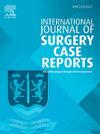Pancreatic panniculitis of the breast following post-ERCP pancreatitis: A case report
IF 0.6
Q4 SURGERY
引用次数: 0
Abstract
Introduction and importance
Pancreatic panniculitis (PP) is a rare dermatological manifestation of pancreatic disease, typically affecting the lower extremities. Breast involvement is exceedingly rare, posing diagnostic challenges as it can mimic inflammatory and neoplastic breast conditions. Recognizing this unusual presentation is crucial to avoid unnecessary interventions.
Case presentation
A 45-year-old woman with a history of laparoscopic surgery for hepatic hydatid cysts, gallbladder disease, and total thyroidectomy developed acute pancreatitis following an endoscopic retrograde cholangiopancreatography (ERCP) procedure for bile leak management. Within hours, she experienced progressive bilateral breast pain, erythema, and peau d'orange changes, initially suspected as mastitis. Imaging revealed inflammatory changes, and histopathological examination confirmed lobular panniculitis with adipocyte necrosis and ghost cells, diagnostic of pancreatic panniculitis. The patient was managed conservatively with intravenous fluids, analgesics, and supportive care, leading to complete symptom resolution.
Clinical discussion
Our findings align with prior reports highlighting the rarity of breast involvement in pancreatic panniculitis despite abundant breast adipose tissue. Histopathology showing lobular panniculitis with ghost cells matched established diagnostic criteria. Unlike previous variable timelines, our case showed a clear temporal link with post-ERCP pancreatitis. Consistent with existing literature, conservative management of pancreatitis successfully resolved skin manifestations, confirming the importance of treating the underlying condition.
Conclusion
Early recognition of pancreatic panniculitis in unusual sites can prevent unnecessary interventions. Conservative treatment of the underlying pancreatic disease remains the cornerstone of management, leading to symptom resolution.
求助全文
约1分钟内获得全文
求助全文
来源期刊
CiteScore
1.10
自引率
0.00%
发文量
1116
审稿时长
46 days

 求助内容:
求助内容: 应助结果提醒方式:
应助结果提醒方式:


